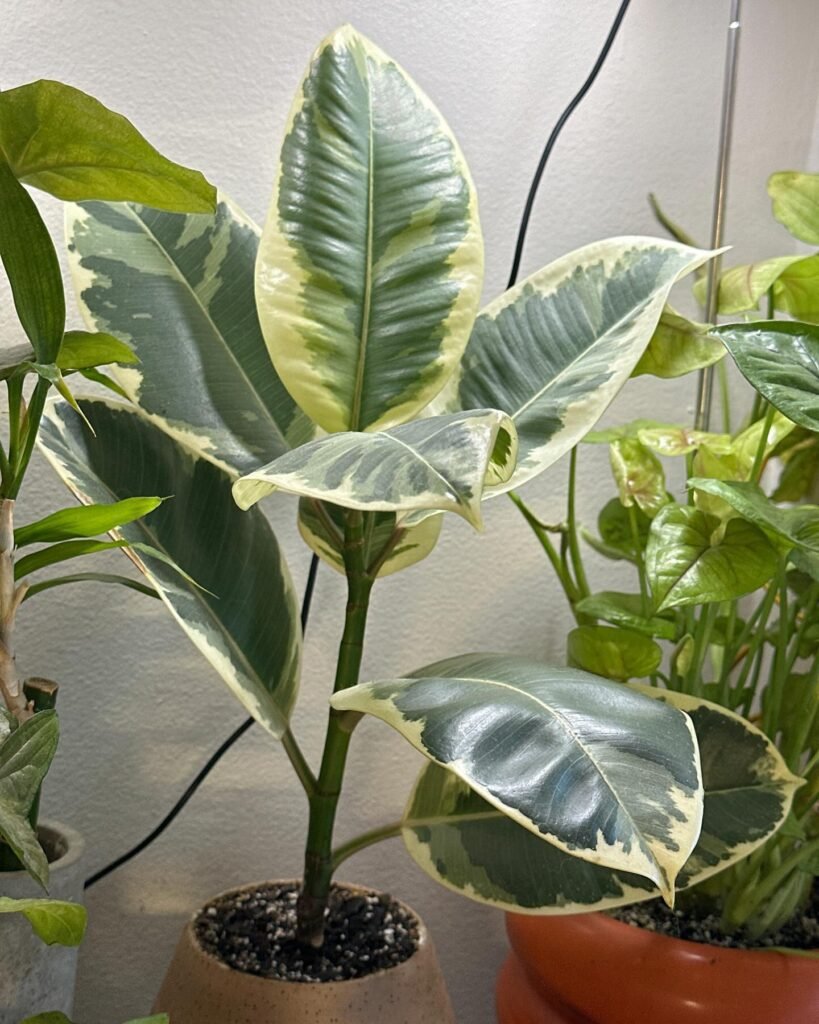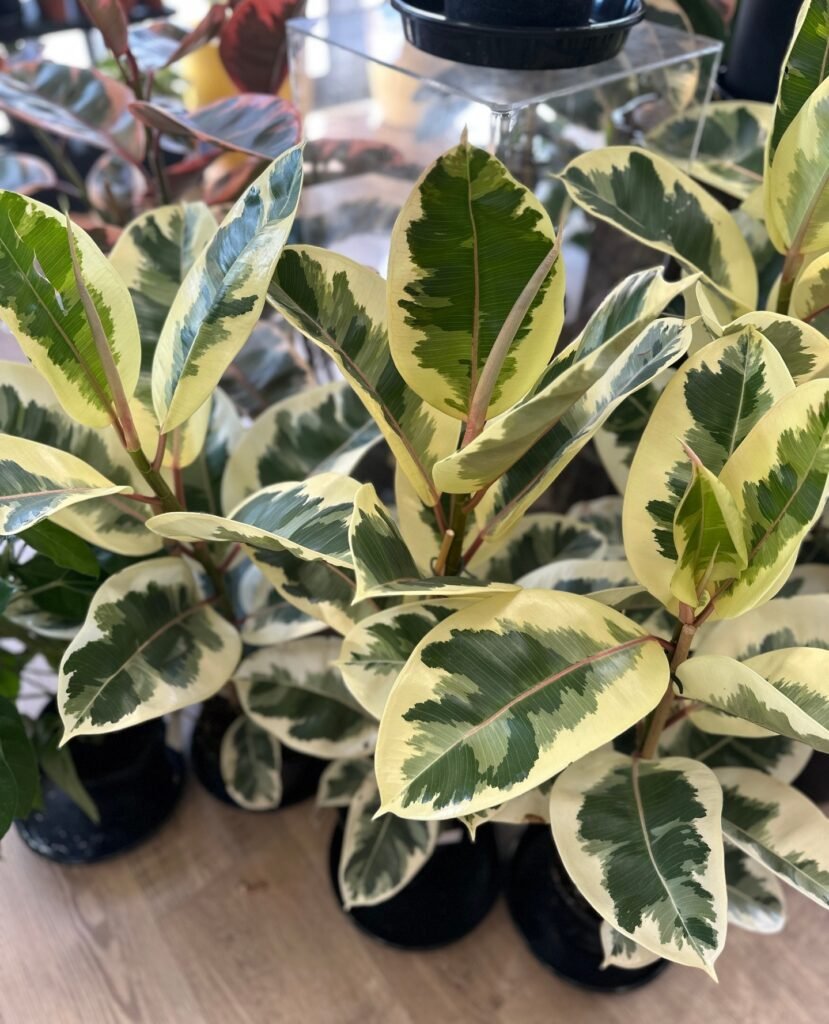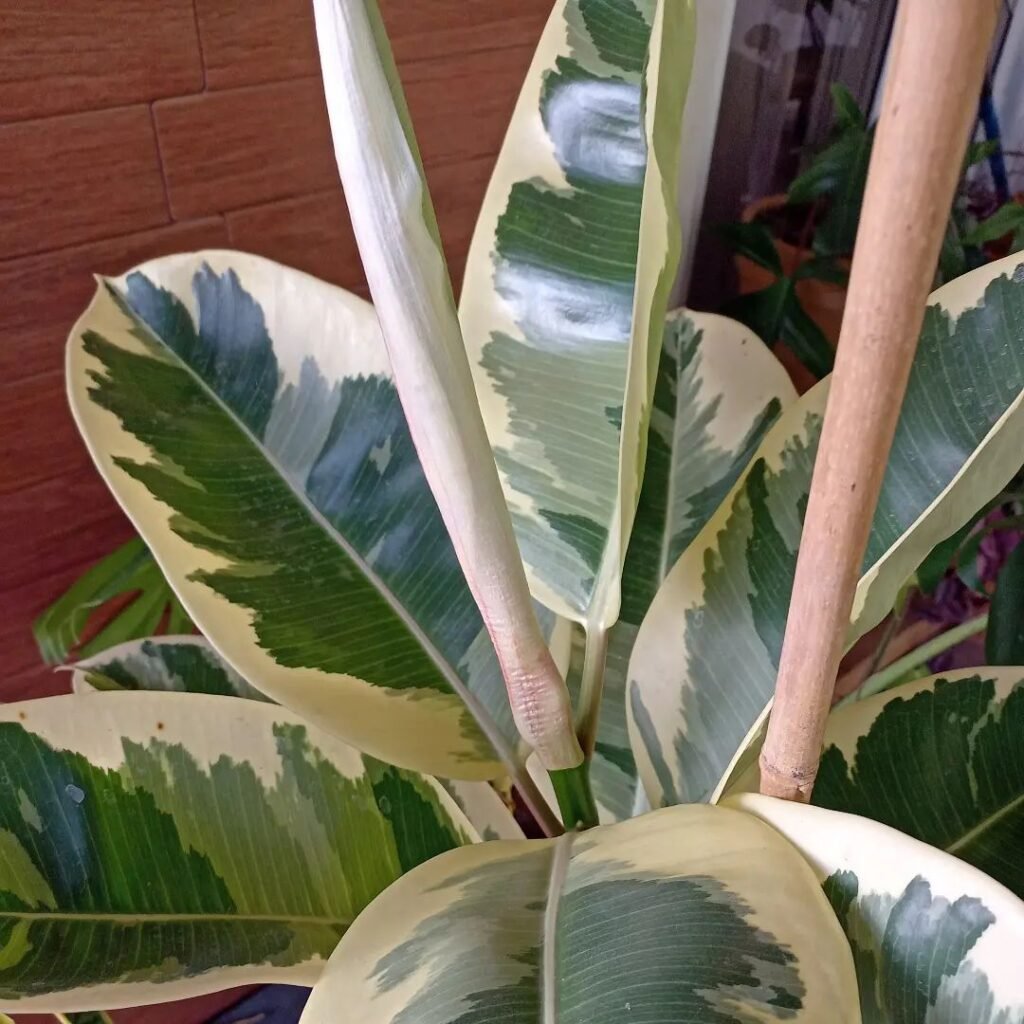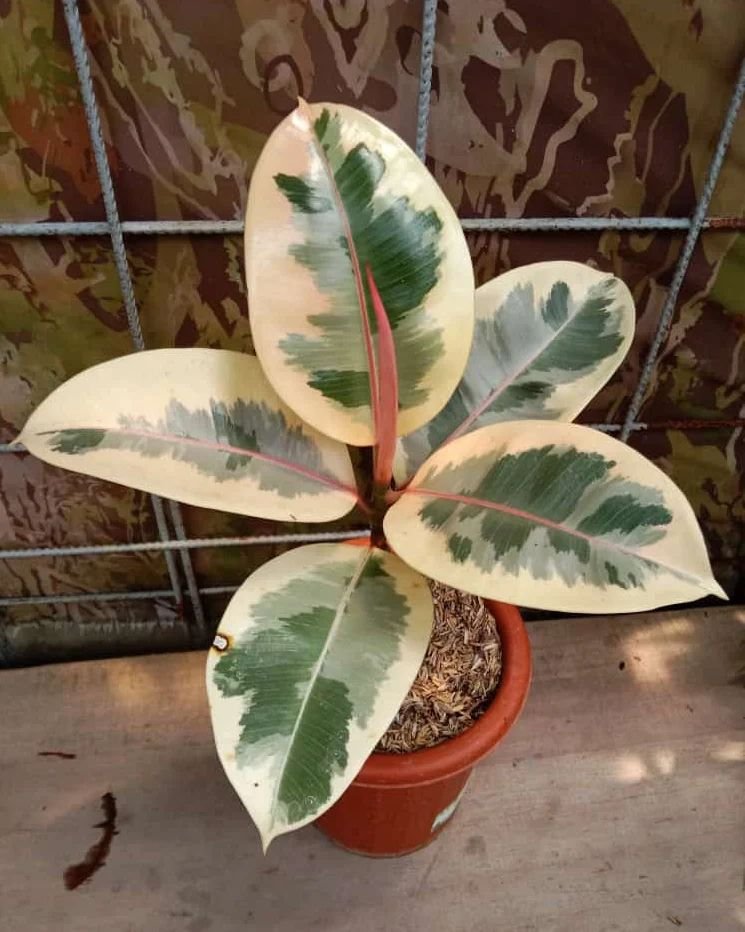Are you looking for a captivating addition to your indoor plant collection? One that not only enhances the aesthetics of your living space but also acts as a natural air filter? Look no further than Ficus Tineke, also known as Variegated Rubber Plant.
This popular houseplant, scientifically known as Ficus elastica Tineke, mesmerizes with its large tropical leaves adorned with stunning green and cream variegation. It’s time to explore the wonders of this captivating foliage plant and discover its secrets to thriving in your home.
Appearance of Ficus Tineke


Ficus Tineke is a stunning indoor plant that captivates with its unique appearance. The standout feature of this plant is its large tropical leaves, which boast a mesmerizing variegation pattern of green and cream. The waxy texture of the leaves adds to the plant’s allure and creates a beautiful contrast against the overall appearance. With its variegated foliage, Ficus Tineke brings a touch of tropical beauty into any room, making it an excellent choice for both plant enthusiasts and interior decorators.
 Did you know the Ficus Tineke is part of the Ficus family, which includes over 850 species? This diverse family ranges from rubber plants to fig trees, showcasing an incredible variety of forms and habitats. The Ficus Tineke, with its unique care needs and growth habits, contributes to the rich tapestry of this plant family’s global presence.
Did you know the Ficus Tineke is part of the Ficus family, which includes over 850 species? This diverse family ranges from rubber plants to fig trees, showcasing an incredible variety of forms and habitats. The Ficus Tineke, with its unique care needs and growth habits, contributes to the rich tapestry of this plant family’s global presence.
Light Requirements for Ficus Tineke


When it comes to caring for your Ficus Tineke, providing the right amount of light is crucial for its overall health and growth. This stunning variegated rubber plant thrives in bright, indirect light, making it an ideal choice for well-lit indoor spaces.
Ficus Tineke can tolerate lower light conditions, but it may not thrive as well compared to when it is exposed to bright, filtered light. Avoid placing your plant in direct sunlight, as this can scorch the leaves and cause damage. Find a suitable location where the plant can receive the bright, indirect light it needs for optimal growth.
“Bright, indirect light is perfect for Ficus Tineke, as it allows the plant to soak up the energy it needs to stay healthy and vibrant,” says plant expert Sarah Anderson. “Direct sunlight, on the other hand, can be too intense and may lead to leaf burns or sun damage. It’s better to provide bright, filtered light to keep your Ficus Tineke happy.”
To ensure your Ficus Tineke gets the right amount of light, consider placing it near a window with a sheer curtain to filter the sun’s rays. You can also position it a few feet away from a south-facing window to avoid direct sunlight. If you have a room with bright, natural light throughout the day, it can be an excellent spot for your Ficus Tineke.
In lower light conditions, such as in rooms with less natural light or farther away from windows, Ficus Tineke can still survive, although its growth may be slower. If you notice that your plant is stretching or leaning towards the light source, it’s an indication that it needs more light.
“Finding the perfect balance of light for your Ficus Tineke comes down to understanding its preferences and observing how it responds to its environment,” explains Anderson. “By providing bright, indirect light and avoiding direct sunlight, you can ensure your Ficus Tineke thrives and continues to showcase its beautiful variegation.”
If you’re unsure whether your Ficus Tineke is receiving the right amount of light, pay attention to the color and health of its leaves. Vibrant shades of green with creamy variegation indicate a healthy plant, while pale or yellowing leaves may be a sign of insufficient light.
Remember, every plant is unique, and it’s essential to monitor your Ficus Tineke’s light requirements and make adjustments as needed. Providing the ideal lighting conditions will contribute to its overall well-being and ensure that it remains a stunning addition to your indoor plant collection.

Watering Tips for Ficus Tineke


When it comes to watering Ficus Tineke, it’s crucial to strike the right balance. This beautiful plant thrives when its soil is slightly moist, but overwatering can have detrimental effects, including leaf drop. To keep your Ficus Tineke healthy and happy, here are some expert watering tips to follow:
- Check the top soil: Before watering, always check the top soil of your Ficus Tineke. If it feels dry to the touch, it’s a sign that it’s time to water the plant.
- Avoid overwatering: Overwatering is one of the common pitfalls that can harm your Ficus Tineke. Make sure not to water the plant excessively, as it can lead to root rot and other problems.
- Watch for signs of overwatering: If you notice yellowing leaves, soggy soil, or a musty smell, it’s a warning sign of overwatering. Adjust your watering frequency accordingly.
- Watering frequency: The watering frequency for Ficus Tineke may vary depending on factors such as temperature, humidity, and the size of the pot. As a general guideline, aim to water the plant when the top inch of soil feels slightly dry.
- Proper drainage is key: Ensure that your Ficus Tineke is potted in a container with proper drainage holes. This will prevent water from pooling in the bottom, reducing the risk of overwatering.
Remember, it’s better to slightly underwater your Ficus Tineke than to overwater it. A slightly dry top soil is a good indicator that your plant is ready for watering. By following these watering tips, you can maintain the ideal moisture level for your Ficus Tineke and help it thrive.

Fertilizing and Soil for Ficus Tineke


When it comes to keeping your Ficus Tineke healthy and thriving, fertilizing and proper soil are key elements to consider. Providing the right nutrients and a well-draining environment will promote optimal plant nutrition and growth throughout the growing season.
Fertilizing Ficus Tineke
I highly recommend regular fertilization for your Ficus Tineke, using a weak dose of liquid fertilizer. This should be done during the growing season to ensure the plant receives the necessary nutrients.
Fertilizers specifically formulated for houseplants or foliage plants are ideal. It’s important to follow the manufacturer’s instructions and avoid over-fertilizing, as this can damage the plant’s roots and lead to nutrient imbalances.
Soil Requirements
Choosing the right soil is equally important for the health of your Ficus Tineke. Opt for a well-draining Ficus potting soil to prevent waterlogged roots, which can lead to root rot and other issues.
A good mix for Ficus Tineke includes a combination of Ficus potting soil, pine bark, and perlite. This mixture ensures proper drainage while providing the necessary nutrients for your plant.
Remember to repot your Ficus Tineke every few years or when it outgrows its current pot. This allows for root growth and prevents the plant from becoming root-bound.
- Regularly fertilize with a weak dose of liquid fertilizer during the growing season.
- Use a well-draining Ficus potting soil mixed with pine bark and perlite.
- Follow the instructions on the fertilizer packaging and avoid over-fertilizing.
- Repot your Ficus Tineke every few years to allow for root growth and prevent root-bound.

Pruning and Maintenance for Ficus Tineke


When it comes to caring for your Ficus Tineke, regular pruning and maintenance are essential. Pruning helps in maintaining the overall aesthetic of the plant and encourages new growth and the development of side shoots.
One important aspect of pruning is the removal of dead leaves and stems. These not only detract from the plant’s appearance but can also hinder its growth. By carefully inspecting your Ficus Tineke regularly and removing any dead foliage, you allow the plant to focus its energy on healthy growth.
Pruning can be done with clean, sharp scissors or pruners. Simply trim off the dead leaves and stems, making sure to cut close to the main stem without damaging the healthy parts of the plant. You can also remove any damaged or diseased foliage during this process.
Aside from the practical benefits, pruning also enhances the overall aesthetic appeal of your Ficus Tineke. By maintaining a tidy appearance, the plant becomes a focal point in any room, adding to its decorative value.
As with any maintenance task, timing plays a crucial role in pruning. It is best to prune your Ficus Tineke in the spring or summer when it is actively growing. During these seasons, the plant has the highest potential for quick recovery and regrowth.

Propagating Ficus Tineke (Variegated Rubber Plant)


Propagating Ficus Tineke is a rewarding way to expand your collection of these beautiful variegated plants. The cutting method is a popular and effective way to propagate Ficus Tineke, and it can be done using stem cuttings. By following simple steps, you can successfully propagate your Ficus Tineke.
- Gather the necessary materials: To propagate Ficus Tineke, you will need a sharp, clean pair of pruning shears or scissors, a container of water or well-draining soil, and a suitable pot if you choose soil propagation.
- Choose a healthy stem cutting: Look for a strong, healthy stem on your Ficus Tineke. It should have at least two sets of leaves and be free from any signs of disease or damage.
- Prepare the stem cutting: Using your pruning shears or scissors, make a clean cut just below a leaf node. This will provide the cutting with the best chance of developing roots.
- Water propagation: If you choose to propagate in water, place the stem cutting in a container filled with room temperature water. Make sure to submerge the lower portion of the cutting, but avoid covering the leaves. Place the container in a location with bright, indirect light and change the water every few days to prevent stagnation.
- Soil propagation: For soil propagation, prepare a well-draining soil mix and fill a suitable pot. Make a small hole in the soil using your finger or a pencil and insert the lower portion of the stem cutting. Gently press the soil around the cutting to ensure stability.
- Care for the propagated cuttings: Whether you choose water or soil propagation, it’s important to provide the right conditions for the cuttings to develop roots. Maintain a warm and humid environment, and avoid direct sunlight that could scorch the leaves. Regularly monitor the moisture level and ensure it remains consistent.
- Monitor root development: Be patient and allow time for the stem cuttings to develop roots. This process can take several weeks or even months, depending on various factors such as temperature and humidity. Once you see new root growth, it indicates that the cutting has successfully propagated.
- Transplanting: Once the new roots have developed, you can consider transplanting the propagated Ficus Tineke into individual pots filled with well-draining soil. This will provide them with the space they need to grow and thrive.
With a little patience and care, you can enjoy the satisfaction of propagating your own Ficus Tineke plants. Whether you choose water propagation or soil propagation, the cutting method offers an accessible way to create new plants and expand your indoor greenery.

Repotting Tips for Ficus Tineke


Repotting is an essential part of caring for your Ficus Tineke. It should be done every two to three years or when the plant starts outgrowing its current pot. Repotting allows for healthy root growth and ensures the plant’s continued vitality.
When selecting a new pot for your Ficus Tineke, choose one that is slightly larger than its current pot. This will provide enough space for the roots to spread out and grow. Avoid going too big as an excessively large pot can slow down growth and result in waterlogged soil.
The next step is choosing the right potting mix. A well-draining mix is ideal for the Ficus Tineke, as it prevents waterlogging and helps maintain a healthy root system. You can create a suitable mix by combining equal parts peat moss, perlite, and potting soil.
When repotting, gently remove the plant from its current pot, being careful not to damage the roots. Place the plant in the new pot, ensuring that it sits at the same depth as before. Fill in the gaps with the potting mix, pressing it firmly to provide stability.
After repotting, thoroughly water the plant to help settle the soil and encourage root growth. Keep in mind that the Ficus Tineke prefers slightly moist soil, so avoid overwatering.
Repotting not only allows for adequate root growth but also helps maintain the plant’s growth rate and overall health. With proper repotting, your Ficus Tineke will continue to thrive and enhance the beauty of your indoor space.
 The Ficus Tineke is a captivating variety of the Rubber Plant, famed for its stunning variegated leaves that feature shades of green, cream, and pink. This plant doesn’t just add a splash of colour to your home; it’s also known for its air-purifying qualities, making your indoor environment fresher and cleaner.
The Ficus Tineke is a captivating variety of the Rubber Plant, famed for its stunning variegated leaves that feature shades of green, cream, and pink. This plant doesn’t just add a splash of colour to your home; it’s also known for its air-purifying qualities, making your indoor environment fresher and cleaner.
Is Ficus Tineke Toxic to Cats and Other Pets?
Ficus Tineke is a beautiful indoor plant that adds a touch of elegance to any space. However, it is essential to be aware of its potential toxicity to cats and other pets. This plant contains latex sap, which can be poisonous if ingested or if it comes into contact with the skin.
If your furry friends have a latex allergy, it is crucial to keep Ficus Tineke out of their reach. The latex sap can cause skin irritation, resulting in discomfort for your pets. Additionally, if ingested, it may lead to asthma symptoms, posing a potential risk to their respiratory health.
To ensure the safety of your beloved pets, exercise caution and consider placing Ficus Tineke in an area where they cannot access it. Keep an eye on your furry friends and consult a veterinarian immediately if any unusual symptoms occur. By taking these precautions, you can enjoy the beauty of Ficus Tineke while keeping your pets safe and healthy.
Helpful Videos about Ficus Tineke
In this special collection, I’ve put together some easy-to-follow videos full of useful tips for looking after your Ficus Tineke. These videos are here to help you learn the simple steps to keep your plant healthy and happy. Perfect for beginners, they’ll show you everything you need to know about caring for your Ficus Tineke, making gardening a breeze.
- Rubber Plant Care & Tips | Grow Healthy Ficus Elastica Tineke/Robusta
- How To Care For Variegated Ficus Elastica
- 10 Simple Tips For A Super Bushy Rubber Plant
FAQ about Growing Your Ficus Tineke

Wondering how to care for your Ficus Tineke? Step into my easy guide for beginners, packed with simple tips to help your Ficus Tineke thrive. From the right amount of light to how often to water and everything in between, I’ve got all the basics covered for you.
It thrives in bright, indirect light. Too much direct sunlight can scorch the leaves, while too little light may cause it to lose its vibrant variegation.
Water when the top inch of soil feels dry. This usually means watering once a week, but adjust based on humidity and light conditions.
Yes, it prefers higher humidity. Regular misting or a pebble tray can help increase humidity around the plant.
Keep it in a warm spot, ideally between 16°C and 24°C. Avoid placing it near cold draughts or radiators.
Use a balanced liquid fertilizer once a month during the growing season (spring and summer), but avoid feeding in winter.
Leaf drop can be caused by stress from over-watering, under-watering, or sudden changes in temperature or light.
Yes, repot in spring every 2-3 years or when it becomes root-bound. Choose a pot that’s slightly larger than the current one.
Prune in spring to shape the plant or remove any dead or damaged foliage. Always use clean, sharp scissors.
Yes, it can be toxic if ingested by pets. Keep it out of reach of curious pets.
Sticky leaves can indicate a pest infestation, such as aphids or scale. Inspect the plant and treat it with insecticidal soap.
Ensure it gets plenty of indirect sunlight, as variegation can fade in low light conditions.
A pot with drainage holes and made from breathable material like terracotta is ideal to prevent waterlogging.
Signs of over-watering include yellowing leaves, soggy soil, and a general look of unhealthiness. Let the soil dry out more between waterings.
In warm climates, it can be placed outside in a shaded spot during summer but should be brought indoors before temperatures drop.
Slow growth can be due to insufficient light, low humidity, or the need for fertilisation. Ensure it’s not too cold and that you’re meeting its care requirements.
Propagation is typically done through stem cuttings. Cut a stem with a few leaves, let it callous for a few hours, then plant in moist soil or water until roots develop.
Brown tips can result from low humidity or over-fertilisation. Try increasing humidity around the plant and reduce the frequency of fertilisation.
I hope this makes it easier for you to look after your Ficus Tineke. If you’ve got any more questions, pop them in the comments, and I’ll answer them. Remember, everyone begins as a novice, and there’s always something new and exciting to learn about caring for your plants.

